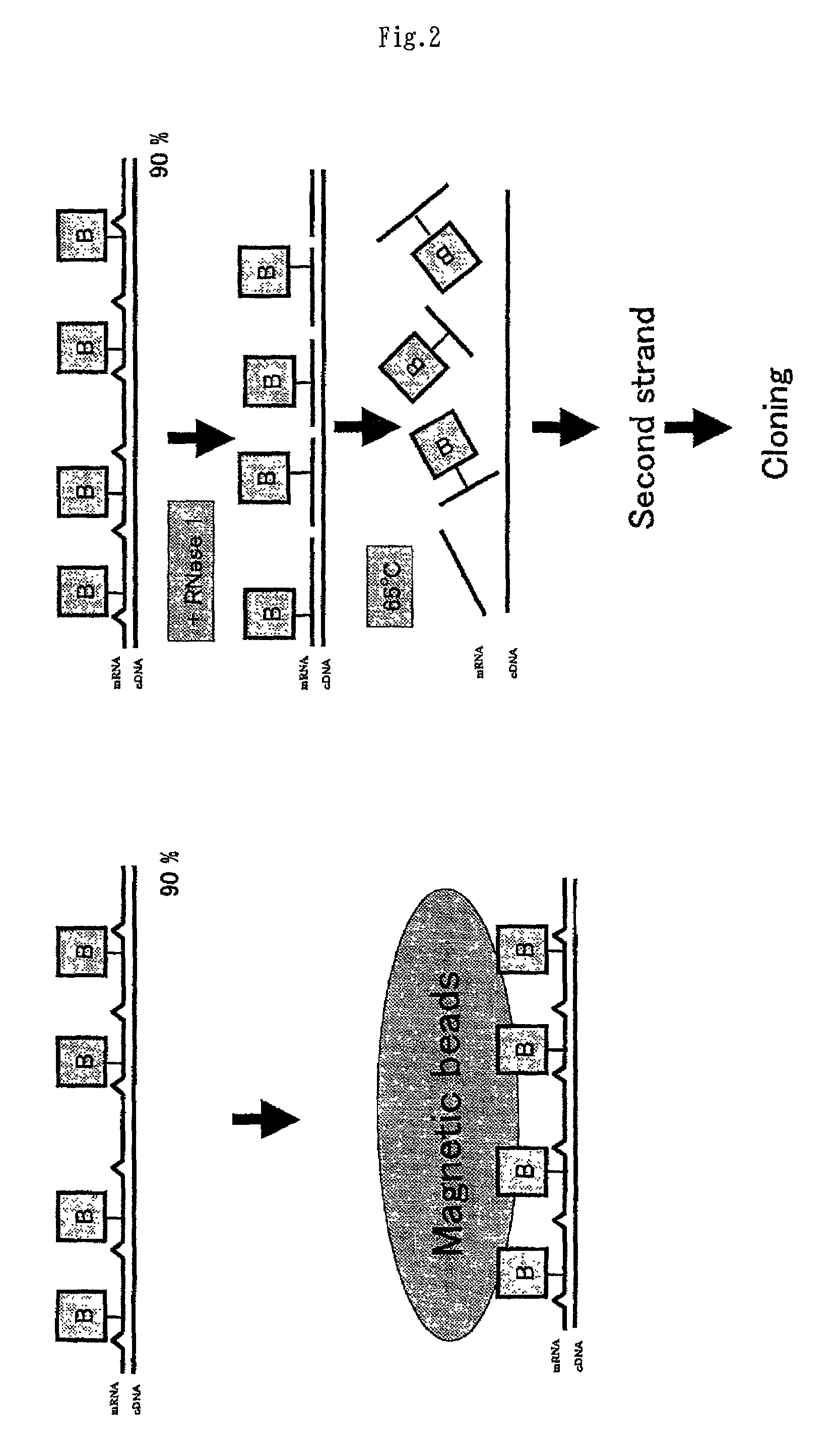Method of preparing normalized and/or subtracted cDNA
a cdna and library technology, applied in the field of preparing normalized and/or subtracted cdna or cdna libraries, can solve the problems of introducing size bias, requiring more cloning and amplification, and requiring long preparation tim
- Summary
- Abstract
- Description
- Claims
- Application Information
AI Technical Summary
Benefits of technology
Problems solved by technology
Method used
Image
Examples
example 1
Preparation of RNA
[0142]Slices of brain tissue (0.5–1 g) (or other tissues as described in Example 2) were homogenized in 10 mL of solution D (Chomczynski , P. and Sacchi, N., 1987, Annal. Biochem., 162:156–159) and extracted with 1 mL of 2M sodium acetate (pH 4.0) and the same amount of a mixture of phenol / chloroform (volume ratio 5:1). After extraction, the same volume of isopropanol was added to the aqueous phase to precipitate RNA. This sample was incubated on ice for an hour and centrifuged at 4000 rpm for 15 minutes with cooling to collect the precipitates. The precipitates were washed with 70 percent ethanol and dissolved in 8 mL of water. A 2 mL quantity of 5M NaCl and 16 mL of an aqueous solution (pH 7.0) comprising 1 percent CTAB (cetyltrimethylammonium bromide), 4M urea, and 50 mM Tris were added to precipitate RNA and the polysaccharides were removed (CTAB precipitate). After centrifugation at 4,000 rpm for 15 minutes at room temperature, the RNA that had been obtained w...
example 2
Lung and Liver Tissues
[0177]cDNA normalized / subtracted libraries (and minilibraries) were prepared from lung and liver tissues in the same manner as described in Embodiment 1 for brain tissue, with the exception that a primer containing an XhoI site (5′(GA)8ACTCGAG(T)16VN-3′) (SEQ ID NO: 4) and an SstI-containing primer 5′-(GA)9GAGCTCACTAGTTTAATTAAATTAATC11-3′ (SEQ ID NO: 3) were employed for mRNA extracted from liver and lung tissues. The other steps were the same as those described for brain tissue.
example 3
Efficiency of Removal in Driver / Tester Capture
Preparation of an RNA Template
[0178]A pBluescript plasmid containing a 5 Kb fragment of reeler cDNA (Hirotsune et al., Nature Genetics, 1995, May, 10(:77–83)) was employed.
[0179]From 2.5 μL of template plasmid DNA (cleaved at the NotI restriction site), RNA was transcribed in vitro under standard conditions: 20 μL of Gibco-BRL 5× buffer, 5 μL of rNTPs (10 mM each), 5 μL of 0.1M DTT, and 20 Units of T7 RNA polymerase at a final volume of 100 μL. The reaction was conducted by incubation at 37° C. for 3 hours. Also, 2 μL of alpha-32 P-rUTP was added in the reaction to label the RNA.
[0180]Subsequently, 20 units of RQ1 DNase (Promega) were added to remove trace quantities of template DNA (plasmid) and the sample obtained was incubated at 37° C. for 15 min. NaCl was added to the sample to a final concentration of 250 mM. The sample obtained was deproteinated once with phenol (equilibrated with Tris) / chloroform and once with chloroform. Two vol...
PUM
| Property | Measurement | Unit |
|---|---|---|
| temperature | aaaaa | aaaaa |
| temperature | aaaaa | aaaaa |
| temperature | aaaaa | aaaaa |
Abstract
Description
Claims
Application Information
 Login to View More
Login to View More - R&D
- Intellectual Property
- Life Sciences
- Materials
- Tech Scout
- Unparalleled Data Quality
- Higher Quality Content
- 60% Fewer Hallucinations
Browse by: Latest US Patents, China's latest patents, Technical Efficacy Thesaurus, Application Domain, Technology Topic, Popular Technical Reports.
© 2025 PatSnap. All rights reserved.Legal|Privacy policy|Modern Slavery Act Transparency Statement|Sitemap|About US| Contact US: help@patsnap.com



